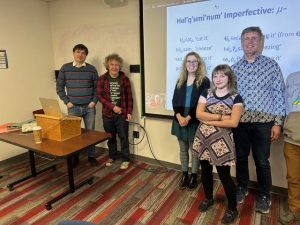We are happy to announce that Gloria Mellesmoen successfully defended her dissertation entitled ‘The Grammar of Salish Reduplication’ this morning (Wednesday March 19th).
Supervisory Committee: Henry Davis (supervisor), Gunnar Hansson and Lisa Matthewson
University Examiners: Stefan Dollinger (English) and Doug Pulleyblank (Linguistics)
External Examiner: Peter Svenonius (University of the Arctic, Tromsø, Norway)
Congratulations, Dr. Mellesmoen!






ABSTRACT
This dissertation proposes a model of the spell-out component of the grammar that accounts for the form and position of reduplicative morpheme across all twenty three Salish languages. The model integrates components of Prosodic Morphology and Moraic Theory, Generalised Nonlinear Affixation, and Stratal Optimality Theory. Its empirical basis is a comprehensive survey of reduplication across the Salish language family, including both published and archival sources. The survey is supplemented by original fieldwork on two languages (Comox-Sliammon and Lillooet) which allows specific predictions of the model to be tested pertaining to the relevant domain(s) for reduplication, the type of phonological material present in lexical entries, and which aspects of the phonological grammar determine if, where and how a reduplicative morpheme is realised.
With respect to domain, a stratum-based model is required to account for the realisation of reduplicative morphemes, including patterns of allomorphy, variation in form and position, and systematic gaps in multiple reduplication patterns. Strata in the model developed here are defined purely on a phonological basis, without reference to morphological domains. This approach also accounts for the form of reduplicative morphemes that include either linear (segmental) or non-linear (prosodic) representations, or a combination of both. To predict the correct surface position of reduplicative morphemes, a two-step model of lexical insertion is adopted. Morphemes are linearised at the first step, prior to the insertion of phonological content; it is only at the second step that differences between linear and non-linear representations emerge. These differences, including the shape and position of suprasegmental and segmental content, are determined by the phonological grammar at the relevant stratum; the phonology determines when and if segments are reduplicated, and if they will be positioned as prefixes, suffixes, or infixes.
This dissertation is the first formal phonological analysis of reduplication that considers the full range of reduplication patterns across the entire Salish language family. Aside from its theoretical contribution, it serves as a comprehensive and accurate documentary source for further theoretical and typological investigation.


